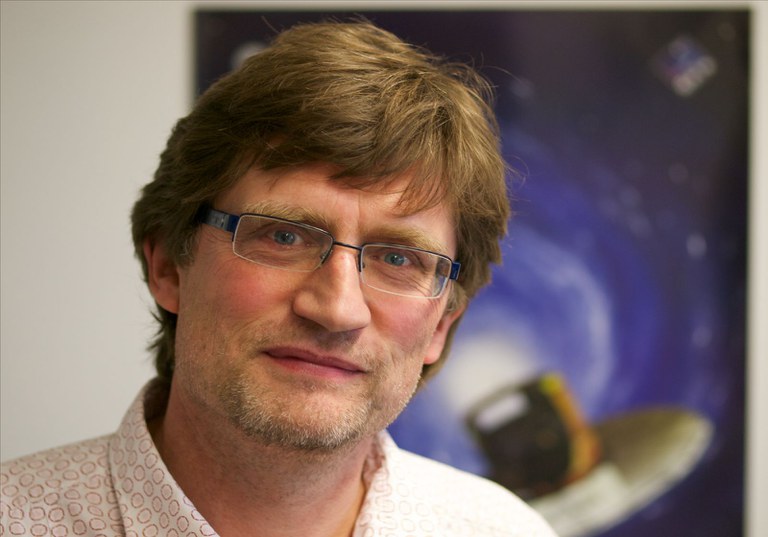Prof. Dr. Willy Kley (1958 - 2021)
On December 21st, 2021, Prof. Dr. Wilhelm Kley passed away completely unexpected and much too early.
 Born in Soest (Westphalia, Germany) on February 19th, 1958, Willy Kley became fascinated in astronomy while still at school. At a young age he spent many cold nights outside, watching the night sky through a little telescope which he kept, and which followed him around the world during his whole life. In 1978, Willy started his physics study at the Ruhr University of Bochum. And in 1980, after one year as exchange student at the University of Sussex, he continued at the Ludwig-Maximilians University, Munich. Prof. Rolf Kudritzki, a young, energetic, and inspiring professor had just been appointed as new director of the University Observatory Munich (USM). So Willy decided to join the USM and in 1985, under the supervision of Gerhard Hensler, he submitted his diploma thesis at the USM on the topic "Hydrodynamical Simulations of Boundary Layers of Accretion Disks in Close Binaries".
Born in Soest (Westphalia, Germany) on February 19th, 1958, Willy Kley became fascinated in astronomy while still at school. At a young age he spent many cold nights outside, watching the night sky through a little telescope which he kept, and which followed him around the world during his whole life. In 1978, Willy started his physics study at the Ruhr University of Bochum. And in 1980, after one year as exchange student at the University of Sussex, he continued at the Ludwig-Maximilians University, Munich. Prof. Rolf Kudritzki, a young, energetic, and inspiring professor had just been appointed as new director of the University Observatory Munich (USM). So Willy decided to join the USM and in 1985, under the supervision of Gerhard Hensler, he submitted his diploma thesis at the USM on the topic "Hydrodynamical Simulations of Boundary Layers of Accretion Disks in Close Binaries".
Willy's interest and excellence in computational astrophysics became already visible at this early stage of his career. Instead of using an available particle-in-cell code, provided by Gerhard Hensler, he developed his own, new grid code with refined mesh resolution at the boundary layer between the accretion disk and the central star. This provided much better spatial resolution and more accurate handling of the complex accretion flow. The results of his diploma thesis, his first papers, appeared in 1987 in the journal Astronomy & Astrophysics. This work also led to a research project, funded by the German Science Foundation, where Willy advanced his code to radiation-hydrodynamics. In 1988, Willy completed his PhD with a thesis on "Radiation Hydrodynamical Models of the Boundary Layer of Accretion Disks". By this time, he had already become a first-ranked international expert on accretion disk modelling.
Willy Kley stayed for two more years at the USM. Then, at the end of 1990, he accepted an invitation of Prof. Douglas Lin for a postdoc position at the University of California in Santa Cruz (UCSC). This was a very productive and creative time. Santa Cruz hosted a lively group of young international postdocs, many now professors in astrophysics, who worked on numerical simulations of proto-planetary disks as well as planet- and star formation and who spent a lot of time together socially. At that time, Santa Cruz, together with other universities and laboratories ran a very active center for star and planet formation. In this inspiring environment, Willy advanced his numerical simulations to both, relativistic as well as proto-stellar accretion disks and finally to proto-planetary disks, at that time, an upcoming new research field which has fascinated him for the rest of his career.
After a one-year employment at Queen Mary and Westfield College in London, where Willy collaborated with John Papaloizou and after another postdoc year at UCSC, Willy joined the newly established Max-Planck research unit "Theory of Gravitation" in Jena, where he completed his habilitation in 1997. In 2000 he accepted a call for a professorship of Computational Astrophysics at the University of Tübingen.
During the two decades at Tübingen, Willy performed his scientific work within national and international research cooperations. He established a large working group and its research results attracted worldwide appreciation. The members of his group will remember his amicable, open, and always inspiring character, with which he created a productive and trusted atmosphere. Willy was in charge of establishing the international Master course on Astro- and Particle Physics at the University of Tübingen that is attracting numerous international students since 2017. With his extraordinary stimulating teaching style he raised the interest in astrophysics of many students.
Willy was an accomplished, internationally leading scientist, a loving, devoted father and husband, and a kind, caring friend. He always appeared to be happy and optimistic. One cannot even imagine him ever being in a bad mood. With his natural talent in designing and constructing top-of-the-line computational tools and innovatively applying them to solve technically challenging fundamental problems, he had an enormous impact in various research fields. This includes the demonstration that migrating planets can capture each other into mean motion resonances and that even Earth-mass planets can migrate both towards or away from their host stars. Everyone who wants to work on planet-disk interactions or radiation hydrodynamics of disks has eventually to study his pioneering scientific papers and reviews. His talks were precise and crisp, conveying a deep understanding and excitement for his field of research. He was always a source of inspiration. His insatiable curiosity, dedicated professionalism and his wonderful sense of humour made him a role model, not only for his students and postdocs but also for his colleagues. He was a man of great talent and wisdom and a gentleman. At the same time, he was a very humble person, easy going and always helpful!
With Willy Kley we have lost an outstanding scientist, an engaged and caring teacher and mentor, and a wonderful colleague and friend.



